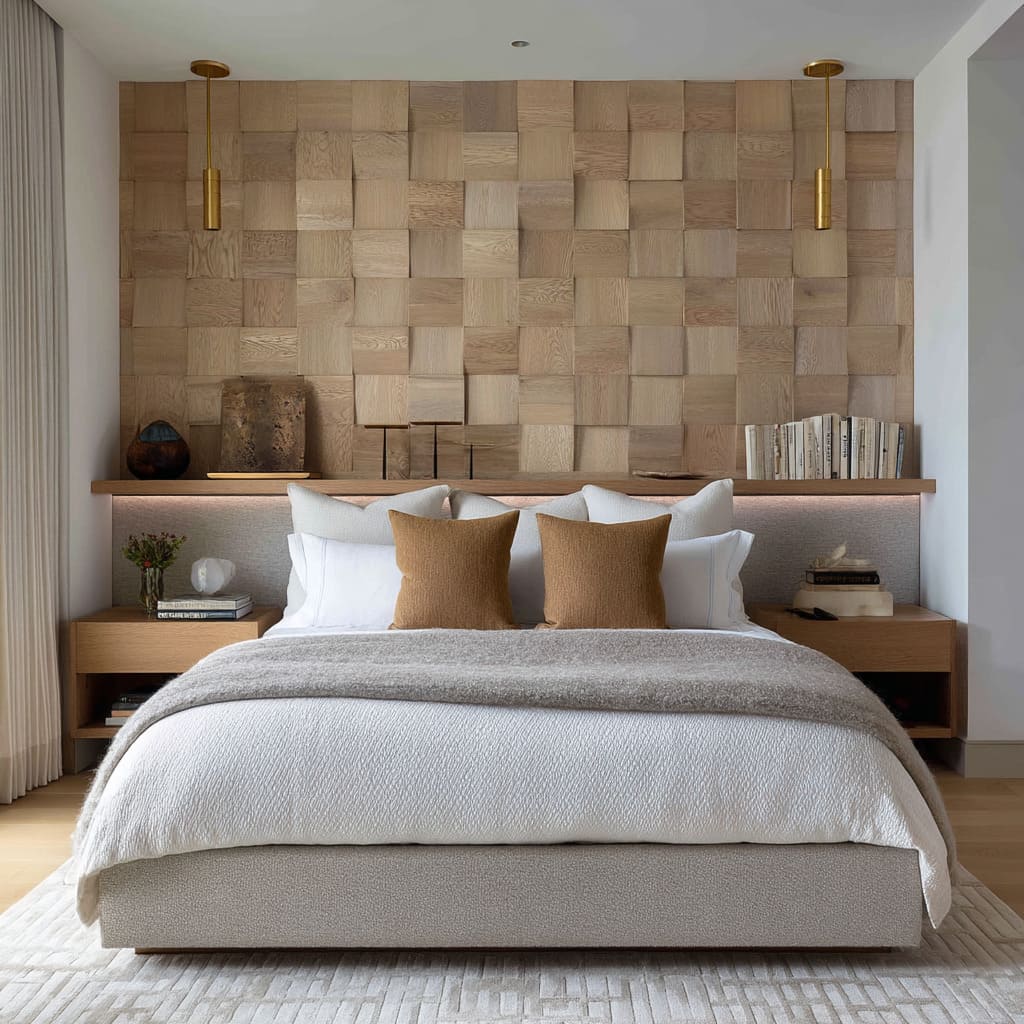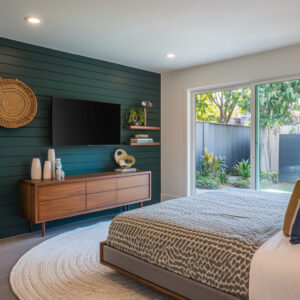Headboards have moved far beyond their early role as decorative panels. In today’s interiors, they often stretch across entire walls, wrap into ceiling alcoves, or anchor lighting and shelving into a single integrated composition.
These aren’t simply accessories—they act as the organizing feature of the room. The shift toward larger, more structural surfaces has brought wood into focus in a new way.
What used to be a narrow band of carved panels is now a full-scale backdrop, layered with slats, grain patterns, and subtle light. Rather than relying on color or ornament, many of these setups let texture, form, and proportion lead.
This approach creates bedrooms where the wall behind the bed isn’t filled, but shaped. Panels may curve, repeat, or break rhythm.
Lighting might skim across the grain in thin strips or glow softly from hidden coves. And every decision—down to the spacing of a single slat or the tilt of a shelf—plays a role in how the space reads.
Across a wide range of styles, from coastal to urban minimalism, these rooms share one thing in common: a quiet control built into their surfaces. This article takes a close look at the ideas shaping modern headboard walls, especially those centered around designer wooden headboards that set the tone through balance, contrast, and quiet detail.
The Wall‑Sized Headboard
In many modern bedrooms, the headboard is no longer a single object behind the bed—it has stretched, grown, and wrapped itself across full walls or even onto ceilings. Wood here begins to behave less like an element of furniture and more like part of the room’s actual structure.
These wooden headboard ideas often involve vertical slats, panels, or geometric assemblies that cover large surfaces behind the bed, framing the sleeping area in a way that feels intentional but never ornamental. Once the wall becomes the anchor, the rest of the furniture seems to respond.
Beds float lightly in front, stripped of visible legs, often fully upholstered in soft wools or bouclés that mute their presence. Bedding, too, seems to quiet down—pillows blend into the setting, and throws fall into place like they’ve always belonged.
With this shift, scale gets rebalanced. Nightstands tend to recede—sometimes floating, sometimes slimmed down—while pendant lights draw longer lines from the ceiling to meet the eye.
Wall art either disappears or becomes texture itself. The bed, no longer backed by a separate frame, claims the central role and reads visually as the only freestanding volume in the space.
This type of wooden headboard design has been gaining ground in many urban and coastal interiors, where visual calm is valued as much as material richness. It’s not about making bold statements—it’s about forming a spatial envelope that does more by doing less.
Light as a Graphic Medium
Slim LED seams, cove strips, and glowing niches are not just illumination—they sketch lines and planes the same way a drafter’s pen would.
| Orientation | What the eye reads first | |
|---|---|---|
| 1 | Vertical seams | Height; a gentle pull upward |
| 2 | Horizontal ribbons | Width; restful lateral flow |
| 3 | Diagonal cut | Motion; a sunrise‑like slice |
| 4 | Full columns | Architectural “pillars” of light |
Insight: where boards meet light at a ninety‑degree angle, grain becomes the shading for the drawn line.
The light is less about brightness and more about outlining negative space.
Rhythm vs. Pause
There’s a measured pulse that runs through headboard walls made from slats, chevron layouts, checkerboard assemblies, or scalloped contours. These patterns build momentum through repetition—wood cut and spaced with precision—but they almost always include one subtle interruption.
That quiet deviation holds more impact than any decoration could. It might be the alignment of pendant lights with vertical slats, stopping the eye for a beat.
In another case, soft fabric panels may land inside a field of angled timber, adding a layer of stillness. Some designs widen only a few slats in an otherwise uniform pattern, gently slowing the rhythm so it never feels rigid.
These moves aren’t decorative flourishes—they act more like punctuation. The spacing, the grain, even the direction of boards, all come together to guide the gaze toward the center.
Almost always, this visual pause lands near the sleeper’s head. It creates a subtle frame—not a literal one, but a zone of focus where the human presence fits into the built rhythm.
This balance between flow and stillness can be found in a range of regional influences—from clean-lined settings in Northern climates to warm, tonal rooms often seen in southwestern layouts. Across the board, the strength of the composition doesn’t come from how much is included—but from what gets left unpatterned, and where that quiet break lands.
Curves, Waves, and Live Edges
Most headboard walls favor straight lines, tight joints, and geometric balance—but some designs break away from this discipline with curves that quietly shift the entire mood. A scalloped edge in dark walnut can turn repetition into rhythm.
A wave-shaped upholstered panel adds motion where only stillness was expected. And when wood bends upward and continues across the ceiling, the whole sleeping space begins to feel cradled, without a single word spoken.
More organic still is the use of a live-edge slab—a surface that doesn’t conform to standard edges, where the shape of the tree is left intact, curving naturally in and out. These pieces often appear against backgrounds that are perfectly squared: clean chevron planks, flat stone blocks, or sharp vertical slats.
That deliberate contrast—one soft, the other strict—makes the flowing line stand out even more.
This kind of curve never comes across as ornamental. It behaves more like a shift in pressure, where the room subtly changes its pace.
One glance, and the shape pulls the eye slowly from one side to the other, inviting a different kind of focus. Paired with neutral tones and low lighting, these shapes become sculptural without needing extra decoration.
In certain spaces, especially those drawing influence from Northern and Pacific interiors, the result feels grounded in form and material rather than styling cues.
Contrast Without Color
Some of the most striking headboard compositions achieve depth without ever leaning on bright hues. They rely instead on tone, finish, and material tension.
In one space, pale oak sits against a matte charcoal wall—suddenly, the wood becomes a source of warmth in the shadows, catching the light softly like skin in evening sun. In another, whitewashed timber panels are paired with a camel leather insert, and the balance feels quiet but full of texture.
Several of these beautiful wood headboards leave out warmth entirely, favoring light ash tones or even soft grays with almost no pigment. What brings the surface to life then isn’t color—it’s the shift in sheen from satin to matte, or the way fibers run vertically while light falls from the side.
Grain patterns begin to carry all the visual weight. In these environments, small accents—like a velvet lumbar cushion in amber or rust—can command as much attention as a large piece of furniture.
Even the wooden bed headboard in such spaces is designed not to dominate, but to stay steady while light and texture do the work. This approach often shows up in interiors where material honesty and balance matter more than impact.
Whether coastal, alpine, or desert-influenced, the restraint is never empty—it sets up the entire room as a study in quiet contrast.
The Illusion of Weightlessness
Some of the most captivating bedrooms achieve their effect not by adding more—but by lifting things away from the floor, quite literally. Floating nightstands, beds without legs, and shelves that seem to rest on nothing all work together to lighten the visual load.
But the trick isn’t in removing structure—it’s in hiding it. This impression of weightlessness often starts with a shadow gap tucked under the bed frame.
Rather than meeting the floor directly, the base is recessed just enough to create a soft absence. That void, though simple, has a powerful effect: it breaks the connection to the ground and leaves the bed hovering in the viewer’s mind, especially under soft light.
Importantly, that gap is never front-lit. It catches reflected glow—whether from ceiling spots, ambient wall washes, or cove lighting.
The result? A bed that doesn’t float at first glance, but gradually appears to lift as the viewer shifts position.
It’s a visual effect that builds with time, not immediacy. In homes that lean into clean lines—coastal, minimalist, even desert-inspired layouts—this quiet elevation gives wooden elements a surprising softness.
Natural wood headboard ideas often benefit from this treatment: once the base lifts and shadows open up underneath, even dense timber starts to feel light in the space. The wood isn’t lighter, but the room reads it that way.
Symmetry Used, Broken, Then Balanced
There’s a familiar calm that comes with symmetry. In many bedrooms, especially those using wood wall headboard ideas as a full backdrop, everything lines up: matching pendant lights, balanced pillows, identical nightstands.
But too much order can flatten a space. That’s why so many interiors interrupt the grid just enough to keep it human.
A headboard might rise slightly higher on one side, its curve shifting off-center like a soft wave. A pair of pendant lights may be the same shape—but dropped at different heights, or fitted with bulbs in slightly warmer tones.
Even something as subtle as a slanted cushion or staggered book stack can break the mirror image without disrupting the balance.
The effect is gentle. While the room holds onto its frame—defined, structured, even architectural—it makes space for something looser, closer to how real people live.
The shift is rarely loud, but it’s enough to avoid the showroom look. Often, the break happens near the head of the bed—right where the sleeper rests.
This directs quiet attention to the place that matters most, while the rest of the symmetry continues to support the scene. In layered interiors across urban lofts, warm-toned ranch homes, or coastal hideaways, this balance between precision and pause shapes a room that feels steady, but never staged.
Micro‑Scale Grain Storytelling
Some of the most memorable headboard walls don’t rely on bold shapes or color shifts—they work at a much closer scale. Grain itself becomes the main feature, manipulated like a texture map that tells a visual story across the wall.
In these kinds of modern wooden headboard designs, the wood isn’t just a surface; it becomes a kind of drawing medium. In some examples, ultra-tight battens line up vertically in such close rhythm that the grain reads like woven cloth—every shadow falling between slats sharp enough to mark time.
Others leave wood raw and aged, allowing knots, streaks, and blackened patches to surface freely. Instead of hiding imperfections, they’re allowed to shape the character of the wall.
There are also designs where each square or panel flips its grain direction—alternating vertical with horizontal—creating a checkerboard that reacts differently depending on where the light comes from. Some panels are bookmatched, meaning two adjoining pieces mirror each other’s grain, forming patterns that ripple out like ink blots or folded wings.
Because the wall sits right behind the bed, the visual scale is unique. These patterns aren’t read across the room—they’re viewed up close, often in contrast to the softness of pillows.
That proximity makes small details stand out. A knot the size of a thumbprint can suddenly feel like a major focal point.
Grain, usually a background element, becomes the foreground texture.
Shelf as Horizon Line
In rooms where headboard walls stretch vertically or use tall slatted patterns, a narrow shelf can become the element that ties everything together. These long, slim ledges don’t command attention, but they set a visual horizon line that breaks up the vertical pull.
That line doesn’t just balance the wall—it offers a spot for low-key styling that feels grounded. Most often, the objects placed on these shelves aren’t mounted but leaned.
A framed print angled gently against the wall, a few books with softened covers, maybe a ceramic piece with a matte finish—this kind of arrangement gives structure without adding weight. It’s a small move, but one that shifts the room away from perfect symmetry and introduces a lived-in softness.
The shelf itself might match the headboard in tone and texture, or it might be slightly lighter, acting as a break between two surface treatments. In any case, its role goes beyond holding things.
It’s a compositional anchor—horizontal in a world of vertical. This approach is especially common in spaces with natural palettes and clean lines—found in hillside homes, lowland retreats, and coastal-inspired interiors.
Among the most creative ideas for headboards, inserting this one thin shelf can often change the reading of the entire wall, even when it spans just a few inches in depth. The decor on it doesn’t need to do much.
The line itself does the work.
Material Pairings that Change Perception of Timber
Wood often does not stand alone:
| Pairing | Visual effect | |
|---|---|---|
| 1 | Wood + glass mirrors | Timber repeats infinitely; surfaces feel twice as tall |
| 2 | Wood + stone | Warm grain pops against cool rugged blocks |
| 3 | Wood + leather | Matteness of hide subdues plank sheen |
| 4 | Wood + concrete gray | Oak warmth heightened by cool neutrality |
Hidden cue: each secondary material is chosen for opposing reflectivity, not just color. The dialogue is about gloss vs.
matte, crisp vs. porous, refined vs.
coarse.
Final Thoughts
The direction of modern headboard design for master bedrooms has shifted from ornament to structure. These pieces no longer sit as accessories—they define the room.
What began as simple backing for a bed now carries the same weight as architectural features: shaping light, grounding layout, and setting a visual rhythm. Some of the most effective designs rely on rethinking scale.
A headboard doesn’t stop at mattress height—it runs from floor to ceiling, or even bends onto the ceiling itself. That move alone changes how everything else fits: nightstands shrink, lighting extends, and walls take on a stronger sense of purpose.
Then there’s the use of lighting—not as a separate feature, but as part of the surface. Thin LED lines traced into grain or slat edges behave like drawn lines.
They’re quiet, but they steer the eye.
Surface texture plays a similar role. Instead of loud contrasts, depth and fiber direction do the heavy lifting.
Grain shifts, panel depth, and direction changes speak more than color ever could. And finally, a certain restraint keeps everything from feeling too mechanical.
One organic curve, one misaligned slat, one live edge—each becomes a small reminder that wood is still a natural material, no matter how controlled its placement. This layered thinking can be found in many custom wood headboard ideas, especially where the goal is to build something quiet but commanding.
These headboards don’t try to take the spotlight. They set the tone for the entire room—silently but with absolute control.























